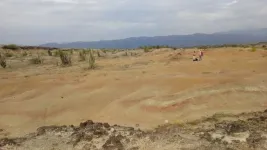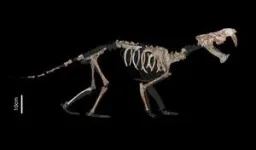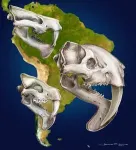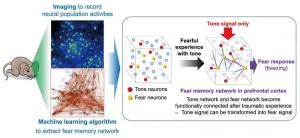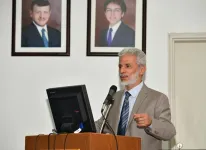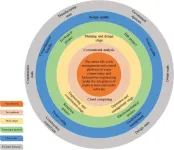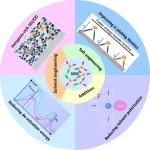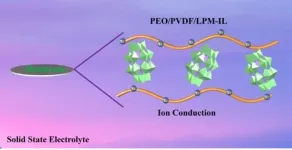(Press-News.org) Recent paleontological explorations in the Tatacoa Desert in Colombia led to the recovery of the most complete skeleton of a "saber-toothed marsupial” discovered in northern South America. The specimen belongs to the species Anachlysictis gracilis, which is part of a group of extinct predatory mammals known as sparassodonts, that lived in South America during the Cenozoic, after the extinction of the dinosaurs.
This species lived approximately 13 million years ago in the area known among paleontologists as ‘La Venta’, in the current La Tatacoa desert, a tropical dry forest that “at that time was a tropical rainforest, similar to the current Amazon,” said Dr. Catalina Suarez, a Swiss National Science Foundation fellow working at the Argentine Institute of Nivology, Glaciology and Environmental Sciences, who led the analysis of the remains and the publication of their results in the scientific journal Geodiversitas.
Prior to this finding, only a piece of a mandible and few additional remains had been found for this species related to living marsupials such as kangaroos, koalas, or opossums. Before it disappeared, A. gracilis was one of a number of terrestrial carnivores in South America, like the pumas, wildcats, foxes, bears and others that currently roam our continent.
“Thanks to this discovery, we were able to learn new details about this fascinating species,” said Suarez. “The analyses allowed us to understand what these extinct predators were like and how they lived in Neotropical South America millions of years ago.”
Suarez began her research on A. gracilis in the laboratory of paleontologist Carlos Jaramillo at the Smithsonian Tropical Research Institute, where she was an intern and a pre- and post-doctoral fellow. She is now a specialist in metatherians, the group that includes marsupials and their extinct relatives, such as the family of Thylacosmilidae to which the fossil of A. gracilis belongs. The most peculiar feature of this family is their curved and flattened canines, resembling the shape of a saber, so they are commonly known as "saber-toothed marsupials".
“Our research confirms that this Colombian fossil ‘saber-tooth marsupial’ A. gracilis, is closely related to Thylacosmilus, which is the most widely recognized ‘saber-tooth marsupial,” said Dr. Javier Luque, a former STRI fellow, co-author of the study and senior research associate at the University of Cambridge Museum of Zoology. “Both groups, together with Patagosmilus (another one of these ‘saber-tooth marsupials’), form their own family in the mammal tree of life, known as Thylacosmilidae. This family is characterized by its long and enormous curved and saber-shaped upper canines, and by an extension of the anterior part of the jaw that looks like the sheath of said 'sabers.”
By analyzing the molar teeth, tooth shape and mandible of the remains, it was possible to define the approximate weight and diet type of A. gracilis. The results revealed that it weighed on average about 23 kg (like a lynx) and was a hypercarnivore that ate only meat, not bone. Its potential prey would have included small mammals that inhabited the area, such as marsupials, spiny rats, porcupines, rodents of various sizes and even primates, which were very abundant in the region.
“In a future study we will address all the other bones in its body, which include various sections of the spine, ribs, hip, scapulae —what we call 'shoulder blades' for humans— and bones in its legs," Suarez said. "This will allow us to explore aspects of how it moved, the position in which its neck held its head, whether it was a runner, whether it could climb, whether its hands could hold objects more easily, as many marsupials do when feeding, or whether it was a bit more difficult, as it is for example for a dog or a cat.”
The new fossil of A. gracilis is housed in the La Tatacoa Natural History Museum, in the town of La Victoria in the municipality of Villavieja (department of Huila, Colombia), along with other surprising finds that have been unearthed in one of the most amazing places on the continent.
“The fossil specimen of A. gracilis that we describe in this research constitutes an iconic fossil because of its excellent preservation, three-dimensionality, and importance for understanding the paleobiological aspects of this predatory marsupial that roamed the forests of northern South America approximately 13 million years ago,” added Dr. Edwin Cadena, researcher at Universidad del Rosario and STRI, and co-author of the study. “With this finding we show the importance of continuing to support paleontological scientific activity in the Neotropics, in order to be able to make new discoveries that will help us understand the evolutionary history and paleobiodiversity of this part of the continent.”
This research was the result of an international collaboration between specialists representing institutions from Argentina (IANIGLA-CCT Conicet Mendoza, Museo de La Plata and Unidad Ejecutora Lillo-CONICET, Fundación Miguel Lillo), Colombia (Universidad del Rosario and Museo de Historia Natural La Tatacoa), United States (Field Museum of Natural History), Japan (Ashoro Museum of Paleontology), Panama (Smithsonian Tropical Research Institute) and United Kingdom (University of Cambridge).
STRI, headquartered in Panama City, Panama, is a unit of the Smithsonian Institution. The institute furthers the understanding of tropical biodiversity and its importance to human welfare, trains students to conduct research in the tropics and promotes conservation by increasing public awareness of the beauty and importance of tropical ecosystems.
END
Extraordinary fossil find reveals details about the weight and diet of extinct saber-toothed marsupial
2023-10-12
ELSE PRESS RELEASES FROM THIS DATE:
Traumatic memories can rewire the brain
2023-10-12
Okazaki, Japan – Scientists have long speculated about the physical changes that occur in the brain when a new memory is formed. Now, research from the National Institute for Physiological Sciences (NIPS) has shed light on this intriguing neurological mystery.
In a study recently published in Nature Communications, The research team has succeeded in detecting the brain neuronal networks involved in trauma memory by using a novel method that combines optical and machine-learning-based approaches, capturing the complex changes that occur during memory formation and uncovering the mechanisms by which trauma memories ...
Could you correctly identify someone wearing sunglasses from a distance of 20 meters?
2023-10-12
This comprehensive study focused on three key factors: distance, lighting and facial masking, and their impact on the ability of eyewitnesses to later correctly identify individuals they have seen. In the study, eyewitnesses were asked to identify perpetrators they had seen from various distances (5, 12.5 or 20 metres) and in different lighting conditions (daylight or deep twilight). The perpetrators were shown both with and without facial masking (sunglasses, hood, or both sunglasses and hood).
The key finding of the study is that distance plays a crucial role – the longer the distance, the harder it is ...
Children with prediabetes and obesity may be more likely to progress to diabetes
2023-10-12
A new Journal of the Endocrine Society study highlights how to identify children at high risk of developing type 2 diabetes and strategies for prevention, such as anti-obesity or anti-diabetes medication and lifestyle changes.
Prediabetes is a health condition in which blood sugar levels are higher than normal, but not yet high enough to be diagnosed as type 2 diabetes. Prediabetes increases the risk of developing chronic kidney disease, heart disease and stroke. Around 5%-10% of adults with prediabetes develop diabetes each year.
Over the past three decades, there has been a sharp increase in the incidence and prevalence ...
Hostile sexism linked to less responsive parenting
2023-10-12
Fathers and mothers who believe that men should hold the power and authority in the family exhibit less responsive parenting behavior, according to a new article in Social Psychological and Personality Science. This research provides the first behavioral evidence demonstrating that hostile sexism is linked to less responsive parenting by both fathers and mothers.
Hostile sexism is characterized by beliefs that men should hold power and authority in society. Its harmful effects are well-established, especially in predicting harmful behavior toward women. However, this new research highlights its impact on parenting ...
Study: Struggling students who repeat third grade see improved achievement
2023-10-12
Washington, October 12, 2023—Third-grade retention can increase the reading and math scores of struggling students, with positive effects lasting into middle school, according to new research released today. The study, by NaYoung Hwang at the University of New Hampshire and Cory Koedel at the University of Missouri, was published today in Educational Evaluation and Policy Analysis, a peer-reviewed journal of the American Educational Research Association.
Video: Co-author NaYoung Hwang discusses findings and implications of the study
Despite mixed reviews among policymakers, researchers, ...
New center addresses global climate change impacts on water, other resources
2023-10-12
Jordan ranks second among countries with the lowest access to water and is expected to reach water insecurity by 2030. Within the country, the most water deprived communities live in the Northeast region of Mafraq’s Azraq Basin which is also home to approximately 120,000 resettled Syrian refugees who are dependent on water resources.
A new three-year program called the Global Center on Climate Change, Water, Energy, Food, and Health Systems, led by the University of California San Diego Herbert Wertheim School of Public Health and Human ...
NIH research program All of Us establishes CU Anschutz-led Center aimed at better utilizing data
2023-10-12
AURORA, Colo. (October 12, 2023) – The National Institutes of Health’s All of Us Research Program has awarded $30 million to the University of Colorado Anschutz Medical Campus and its partners to establish the Center for Linkage and Acquisition of Data (CLAD). The All of Us Research Program is a historic effort to enroll at least 1 million people who reflect the diversity of the United States. Providing researchers with the data will help drive new discoveries and advance precision medicine.
“This is ...
Team develops HydroBIM platform for design of hydropower hub buildings
2023-10-12
A research team has developed a platform based on building information modeling (BIM) technology for use in the design of hydropower hub buildings. The platform, called HydroBIM, combines BIM technology with geographic information systems, computer-aided engineering, internet of things, artificial intelligence, and other technologies. The HydroBIM platform provides a comprehensive approach to digital design, intelligent construction, and smart operation of hydropower engineering projects.
The work ...
Stronger lithium batteries may need ‘weaker’ solvation structure, researchers report
2023-10-12
Lithium batteries power our phones, computers, many of our cars and so much more — even the drill and weedwhacker. But as technology advances, can they keep up in their current format? No, but there is a way forward, according to a new review paper from researchers at Hong Kong Polytechnic University, by further developing the electrolytes that allow for energy storage and discharge.
The team published their work in Energy Materials and Devices on September 18, 2023.
“Lithium batteries ...
Polyoxometalates and ionic liquid enhance solid-state lithium-ion electrolyte performance
2023-10-12
Polyoxometalates (POMs) containing charged lithium ions combined with ionic liquids, increase the ion conductivity of a solid-state electrolyte membrane.
Solid-state lithium-ion batteries depend on the movement of ions (charged atoms) in the solid, rather than liquid, state to either charge or discharge the battery. These solid-state electrolytes are safer, more cost efficient and capable of higher energy densities than batteries that rely on liquid electrolyte solutions, but suffer from low ionic conductivity, or movement of ions, and poor thermal stability. A new composite ...
